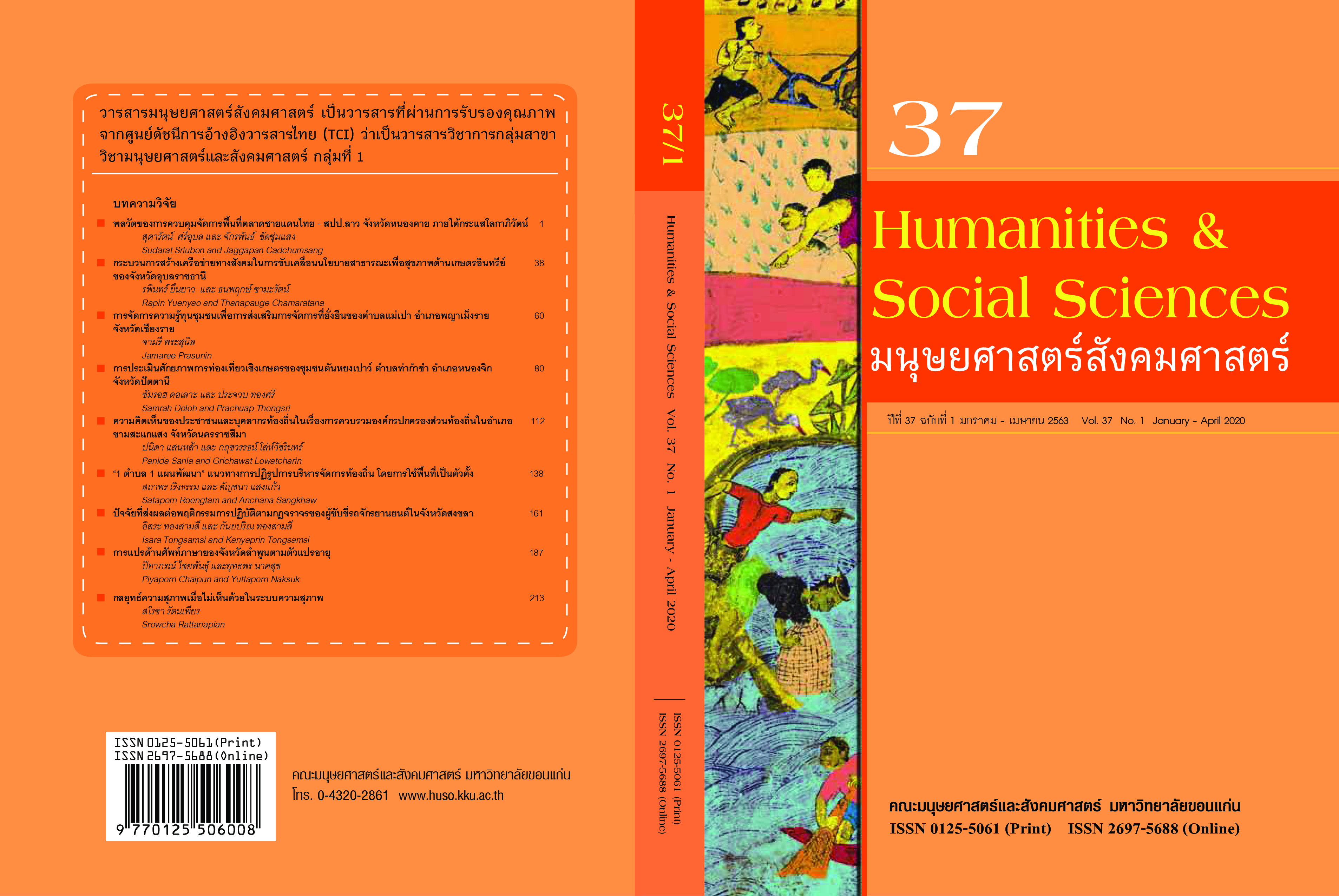ปัจจัยที่ส่งผลต่อพฤติกรรมการปฏิบัติตามกฎจราจรของผู้ขับขี่รถจักรยานยนต์ในจังหวัดสงขลา
Factors affecting Traffic Rule Compliance Behavior of Motorcycle Riders in Songkhla Province
Keywords:
Behavioral Intention, Traffic Rule Compliance, Motorcycle Riders, Songkhla ProvinceAbstract
The increasing popularity of motorcycles in Thailand was a significant concern as motorcycle riders
represent 76% of all road accidents and an even greater proportion of serious injuries. This study was to explain factors affecting traffic rule compliance behavior and determine the mediator effect of behavioral intention in the relationship between perceived behavioral control and traffic rule compliance behavior. Data was collected from 590 young riders in Songkhla province by means of structured questionnaires. Data was analyzed with partial least square structural equation modeling technique. The results showed that the TPB model explained 77.6% of the variance in compliance intentions and 65.3% of compliance behavior. Besides, the direct effect of attitude and subjective norm on behavioral intention, and perceived behavioral control on traffic rule compliance behavior were also confirmed in this study. According to our findings clearly demonstrated that the relationship between perceived behavioral control and traffic rule compliance behavior was better understood if the influence of behavioral intention, as a mediating variable of the aforementioned relationship, was taken into account. To summarize, the findings of this study provided a preliminary support for the theory of planned behavior as an effective framework for examining rule compliance in young riders.
References
สำนักงานสถิติแห่งชาติ. (2560). สถิติการรับแจ้งคดีอุบัติเหตุการจราจรทางบก จำแนกตามประเภทรถความเสียหายและผู้ต้องหา จังหวัดสงขลา พ.ศ. 2556-2558. กรุงเทพฯ : ผู้แต่ง.
สำนักงานขนส่งจังหวัดสงขลา. (2560). สถิติการเปรียบเทียบปรับผู้ฝ่าฝืนกฎหมายว่าด้วยรถยนต์ จําแนกตามประเภทรถ ของปีงบประมาณ 2560. สงขลา : ผู้แต่ง.
Ajzen, I. (2015). The theory of planned behaviour is alive and well, and not ready to retire: a commentary on Sniehotta, Presseau, and Araújo-Soares. Health Psychology Review. 9(2), 131-137.
Ajzen, I. (2012). The theory of planned behavior. In P. A. M. Lange, A. W. Kruglanski & E. T. Higgins (Eds.), Handbook of theories of social psychology (Vol. 1, pp. 438-459). London, UK: Sage.
Ajzen, I. (2011). The theory of planned behavior: Reactions and reflections. Psychology & Health, 26 (9), 1113-1127.
Ajzen, I. (1991). The theory of planned behavior. Organizational Behavior and Human Decision Processes, 50, 179-211.
Ajzen, I. & Sheikh, S. (2013). Action versus inaction: Anticipated affect in the theory of planned behavior. Journal of Applied Social Psychology, 43(1), 155-162.
Ali, M., Saeed, M. M. S., Ali, M. M. & Haida, N. (2011). Determinants of helmet use behaviour among employed motorcycle riders in Yazd, Iran based on theory of planned behavior. Injury. 42, 864-869.
Brijs, K., Brijs, T., Sann, S., Trinhm, T. A., Wets, G. & Ruiter, R. A. C. (2014). Psychological determinants of motorcycle helmet use among young adults in Cambodia. Transportation Research Part F. 26, 273-290.
Chen, C. F. & Chen, C. W. (2011). Speeding for fun? Exploring the speeding behavior of riders of heavy motorcycles using the theory of planned behavior and psychological flow theory. Accident Analysis and Prevention. 43, 983-990.
Chorlton, K., Conner, M. & Jamson, S. (2012). Identifying the psychological determinants of risky riding: An application of an extended Theory of Planned Behaviour. Accident Analysis and Prevention. 49, 142-153.
Elliott, M. (2010). Predicting motorcyclists’ intentions to speed: Effects of selected cognitions from the theory of planned behaviour, self-identity and social identity. Accident Analysis and Prevention. 42, 718-725.
Eyssartier, C., Meineri, S. & Gueguen, N. (2017). Motorcyclists’ intention to exceed the speed limit on a 90 km/h road: Effect of the type of motorcycles. Transportation Research Part F. 45, 183-193.
Ghasemzadeha, S., Babazadeha, T., Allahverdipourb, H., Sadeghi-Bazargani, H. & Kouzekanani, K. (2017). Cognitive-behavioral determinants of using helmet by motorcyclists in a rural community. Journal of Transport & Health. http://dx.doi.org/10.1016/j.jth.2017.04.007.
Hair, J. F., Hult, G. T. M., Ringle, C. M. & Sarstedt, M. (2014). A Primer on Partial Least Squares Structural Equation Modeling (PLS-SEM). Thousand Oaks, CA: Sage.
Hair, J. F., Ringle, C. M. & Sarstedt, M. (2011). PLS-SEM: Indeed a silver bullet. Journal of Marketing Theory and Practice, 19(2), 139–151.
Leandro, M. (2012). Young drivers and speed selection: A model guided by the Theory of Planned Behavior. Transportation Research Part F. 15, 219-232.
Lheureux, F., Auzoult, L., Charlois, C., Hardy-Massard, S. & Minary, J. P. (2016). Traffic offences: planned or habitual? Using the theory of planned behaviour and habit strength to explain frequency and magnitude of speeding and driving under the influence of alcohol. British Journal of Psychology. 107, 52-71.
Ozkan, T., Lajunen, T., Dogruyol, B., Yildirim, Z. & Coymak, A. (2012). Motorcycle accidents, rider behaviour, and psychological models. Accident Analysis and Prevention. 49, 124-132.
Palat, B. & Delhomme, P. (2012). What factors can predict why drivers go through yellow traffic lights? An approach based on an extended Theory of Planned Behavior. Safety Science. 50, 408-417.
Ringle, C. M., Wende, S. & Will, A. (2005). SmartPLS 2.0.M3. Hamburg: SmartPLS, http://www.smartpls.de.
Susilo, Y. O., Joewono, T. B. & Vandebona, U. (2015). Reasons underlying behaviour of motorcyclists disregarding traffic regulations in urban areas of Indonesia. Accident Analysis and Prevention. 75, 272-284.
Tankasem, P., Satiennam, T. & Satiennam, W. (2016). Psychological factors influencing speeding intentions of car drivers and motorcycle riders in urban road environments. International Journal of Technology. 7, 1179- 1186.
Trinha, T. A. & Le, T. P.L. (2016). Motorcycle helmet usage among children passengers: role of parents as promoter. Procedia Engineering. 142, 10-17.
Tunnicliff, D. J., Watson, B. C., White, K. M., Hyde, M. K., Schonfeld, C. C. & Wishart, D. E. (2012). Understanding the factors influencing safe and unsafe motorcycle rider intentions. Accident Analysis and Prevention. 49, 133-141.
Watson, B., Tunnicliff, D., White, K., Schonfeld, C. & Wishart, D. (2007). Psychological and Social Factors Influencing Motorcycle Rider Intentions and Behavior. Australia: Australian Transport Safety Bureau.


